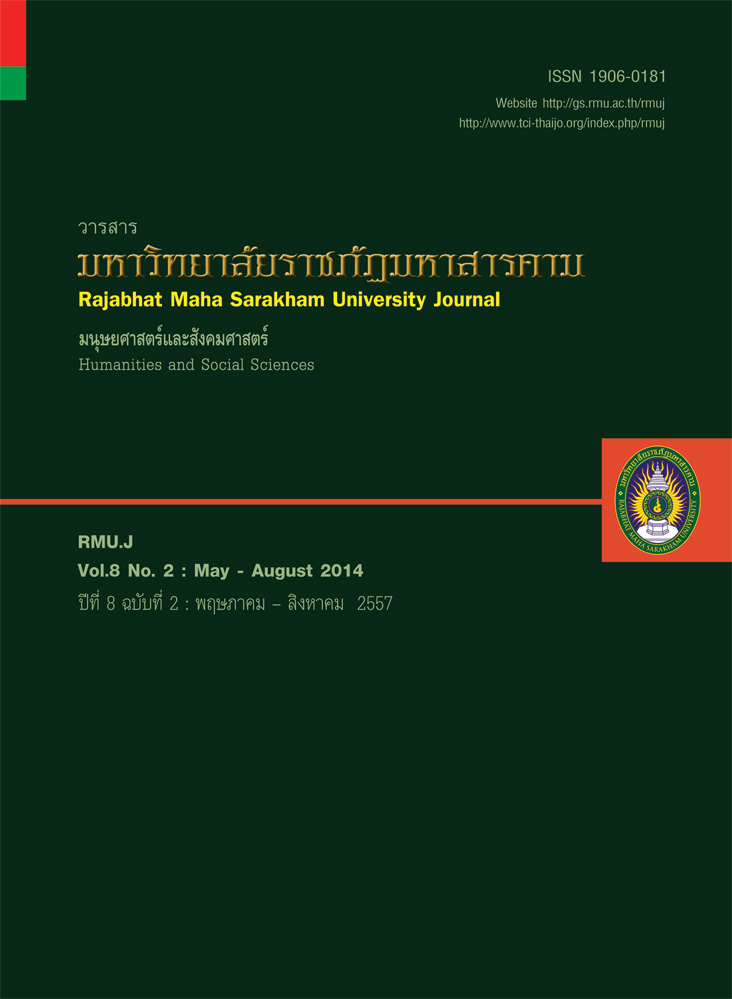ผลการเรียนด้วยบทเรียนบนเว็บแบบผสมผสานโดยใช้ปัญหาเป็นฐานกับการเรียนแบบใช้ปัญหาเป็นฐาน เรื่อง เทคโนโลยีสารสนเทศและการสื่อสาร ชั้นมัธยมศึกษาปีที่ 2 Effects of Learning through Blended Web-based Instruction Based on the Problems by Using Problem-based Learnin
Main Article Content
บทคัดย่อ
การวิจัยครั้งนี้มีวัตถุประสงค์ ประการแรก เพื่อพัฒนาบทเรียนบนเว็บแบบผสมผสานโดยใช้ปัญหาเป็นฐาน เรื่องเทคโนโลยี
สารสนเทศและการสื่อสาร ที่มีประสิทธิภาพตามเกณฑ์ 80/80 ประการที่สอง เพื่อหาดัชนีประสิทธิผลของการเรียนด้วยบทเรียนบน
เว็บแบบผสมผสานโดยใช้ปัญหาเป็นฐาน ที่พัฒนาขึ้น ประการที่สาม เพื่อเปรียบเทียบความสามารถในการแก้ปัญหาก่อนและหลังเรียน
ด้วยบทเรียนบนเว็บแบบผสมผสานโดยใช้ปัญหาเป็นฐาน ที่พัฒนาขึ้น ประการที่สี่ เพื่อเปรียบเทียบผลสัมฤทธิ์ทางการเรียนและความ
สามารถในการแก้ปัญหา ของนักเรียนที่เรียนด้วยบทเรียนบนเว็บแบบผสมผสานโดยใช้ปัญหาเป็นฐานกับการเรียนแบบใช้ปัญหา
เปน็ ฐาน และประการที่หา้ เพือ่ ศกึ ษาความคงทนในการเรยี นร ู้ ของนกั เรยี นที่เรยี นดว้ ยบทเรยี นบนเว็บแบบผสมผสานโดยใชป้ ญั หาเปน็
ฐาน กลุ่มตัวอย่างในการวิจัยครั้งนี้เป็นนักเรียนชั้นมัธยมศึกษาปีที่ 2 ภาคเรียนที่ 1 ปีการศึกษา 2556 ได้มาโดยการสุ่มตัวอย่างแบบ
กลุ่ม (Cluster random sampling) โดยนักเรียนโรงเรียนบ้านเหล่าพิทยาคมเป็นกลุ่มทดลอง และนักเรียนโรงเรียนหนองหว้า
(ประชาสรรค์) เป็นกลุ่มควบคุม โรงเรียนละ 30 คน เครื่องมือที่ใช้ในการวิจัยคือ 1) บทเรียนบนเว็บแบบผสมผสานโดยใช้ปัญหา
เป็นฐาน 2) แผนการจัดการเรียนรู้แบบใช้ปัญหาเป็นฐาน 3) แบบทดสอบวัดผลสัมฤทธิ์ทางการเรียน แบบปรนัย 4 ตัวเลือก จำนวน
40 ข้อ ที่มีค่าความยากตั้งแต่ 0.20 ถึง 0.80 ค่าอำนาจจำแนกตั้งแต่ 0.20 ถึง 1.00 และค่าความเชื่อมั่นทั้งฉบับเท่ากับ 0.91 และ 4)
แบบวัดความสามารถในการแก้ปัญหา แบบปรนัย 4 ตัวเลือก 10 สถานการณ์ สถานการณ์ละ 4 ข้อ จำนวนทั้งหมด 40 ข้อ ที่มีค่า
ความยากตั้งแต่ 0.20 ถึง 0.80 ค่าอำนาจจำแนกตั้งแต่ 0.20 ถึง 1.00 และค่าความเชื่อมั่นทั้งฉบับเท่ากับ 0.90 สถิติที่ใช้วิเคราะห์ข้อมูล
คือ ร้อยละ ค่าเฉลี่ย ส่วนเบี่ยงเบนมาตรฐาน การทดสอบสมมติฐานด้วย t-test (Dependent samples) และ F-test (One way
MANOVA)
ผลการวิจัยพบว่า
1. บทเรียนบนเว็บแบบผสมผสานโดยใช้ปัญหาเป็นฐาน เรื่องเทคโนโลยีสารสนเทศและการสื่อสาร มีค่าประสิทธิภาพเท่ากับ
80.92/86.75
2. ดัชนีประสิทธิผลของบทเรียนบนเว็บแบบผสมผสานโดยใช้ปัญหาเป็นฐาน ที่พัฒนาขึ้นมีค่าเท่ากับ 0.7854
3. นักเรียนที่เรียนด้วยบทเรียนบนเว็บแบบผสมผสานโดยใช้ปัญหาเป็นฐาน เรื่องเทคโนโลยีสารสนเทศและการสื่อสารมีความสามารถในการแก้ปัญหาหลังเรียนสูงกว่าก่อนเรียนอย่างมีนัยสำคัญทางสถิติที่ระดับ .05
4. นักเรียนที่เรียนด้วยบทเรียนบนเว็บแบบผสมผสานโดยใช้ปัญหาเป็นฐาน เรื่องเทคโนโลยีสารสนเทศและการสื่อสาร
มีผลสัมฤทธิ์ทางการเรียนและความสามารถในการแก้ปัญหาสูงกว่านักเรียนที่เรียนโดยปัญหาเป็นฐาน อย่างมีนัยสำคัญทางสถิติ .05
5. นักเรียนที่เรียนด้วยบทเรียนบทเว็บแบบผสมผสานโดยใช้ปัญหาเป็นฐาน เรื่องเทคโนโลยีสารสนเทศและการสื่อสาร
มีความคงทนในการเรียนรู้ไม่แตกต่างหลังเรียนผ่านไป 2 สัปดาห์ โดยมีคะแนนเฉลี่ยของความแตกต่างระหว่างคะแนนสอบ
หลังเรียน 0.57
This research aimed: firstly, to develop blended web-based instruction using problem-based learning
entitled “Information and Communication Technology” with required efficiency of 80/80; secondly, to find out
effective index of learning with the developed blended web-based lessons; thirdly, to compare problem solving
ability before and after learning through the blended web-based instruction; fourthly, to compare learning
achievement and problem-solving ability before and after learning through the blended web-based instruction;
and finally, to study learning retention of students who learned with the blended web-based instruction. The
samples were the grade 8th students in the first semester of the academic year 2013, selected through cluster
random sampling. The treatment group was Banloawpittayakom School and the control group was Bannongwa
(Pracharsan) School. Each class initially consisted of 30 students. The instruments used in this research were:
1) blended web-based instruction using problem-based learning, 2) lesson plans using problem-based
learning, 3) a 40-item of 4 multiple choices achievement test which had a difficulty level between 0.20-0.80,
a rank of discriminating at 0.20-1.00, with 0.91 of reliability, and 4) a 40- item of 4 multiple choices of problem
solving skill which had a difficulty level between 0.20 - 0.80, a rank of discriminating at 0.20-1.00, with 0.90
of reliability. The statistics used in the research were percentage, mean, standard deviation, and t-test
(dependent sample) and F test (one way MANOVA) for hypothesis testing.
The results of the study were as follows:
1. The developed blended web-based instruction using problem-based learning had an efficiency
of 80.92/86.75.
2. The developed blended web-based instruction using problem-based learning had an effectiveness
index of 0.7854.
3. The students who had learned with blended web-based instruction using problem-based learning
showed that their greater problem solving skills than before learning was significantly at the .05 level.
4. The students who had learned by using the blended web–based instruction using problem- based
learning had higher achievement test on problem solving skill than those who learned by problem- based
learning at the .05 level of significance .
5. The students who had learned using the blended using problem-based learning could retain
their knowledge after two weeks of learning by difference in mean calculator after learning at 0.57.
Article Details
1. บทความที่ลงตีพิมพ์ทุกเรื่องได้รับการตรวจทางวิชาการโดยผู้ประเมินอิสระ ผู้ทรงคุณวุฒิ (Peer Review) สาขาที่เกี่ยวข้อง อย่างน้อย 3 ท่าน ในรูปแบบ Double blind review
2. ข้อคิดเห็นใด ๆ ของบทความที่ลงตีพิมพ์ในวารสารมหาวิทยาลัยราชภัฏมหาสารคาม นี้เป็นของผู้เขียน คณะผู้จัดทำวารสารไม่จำเป็นต้องเห็นด้วย
3. กองบรรณาธิการวารสารมหาวิทยาลัยราชภัฏมหาสารคาม ไม่สงวนสิทธิ์การคัดลอกแต่ให้อ้างอิงแสดงที่มา


